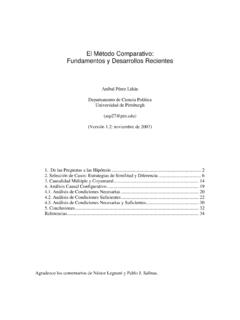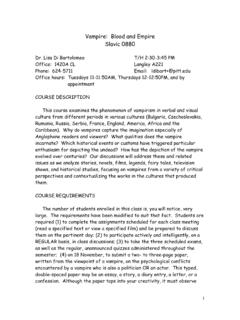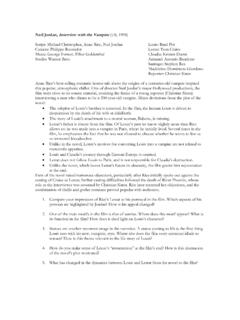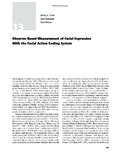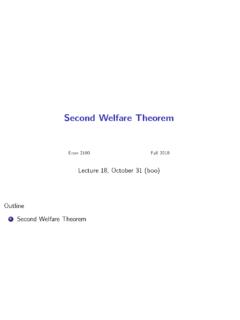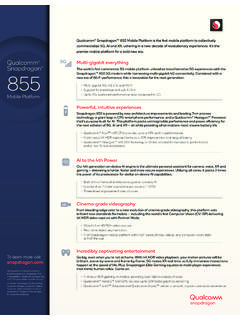Transcription of Development of perceptual expertise in emotion recognition
1 ARTICLE IN PRESS. Cognition xxx (2008) xxx xxx Contents lists available at ScienceDirect Cognition journal homepage: Brief article Development of perceptual expertise in emotion recognition Seth D. Pollak a,*, Michael Messner a, Doris J. Kistler b, Jeffrey F. Cohn c a Department of Psychology and Waisman Center, University of Wisconsin at Madison, 1500 Highland Avenue, Madison, WI 53711, USA. b University of Louisville, The Heuser Hearing Institute,117 E. Kentucky Street, Louisville, KY 40203, USA. c University of Pittsburgh, 4327 Sennott Square, Pittsburgh, PA 15260, USA. a r t i c l e i n f o a b s t r a c t Article history: How do children's early social experiences in uence their perception of emotion -speci c Received 23 March 2007 information communicated by the face?
2 To examine this question, we tested a group of Revised 29 September 2008 abused children who had been exposed to extremely high levels of parental anger expres- Accepted 3 October 2008. sion and physical threat. Children were presented with arrays of stimuli that depicted the Available online xxxx unfolding of facial expressions, from neutrality to peak emotions . The abused children accurately recognized anger early in the formation of the facial expression, when few phys- Keywords: iological cues were available. The speed of children's recognition was associated with the emotion perception Face processing degree of anger/hostility reported by the child's parent. These data highlight the ways in Effects of experience which perceptual learning can shape the timing of emotion perception.
3 Developmental plasticity 2008 Elsevier All rights reserved. Child abuse emotion recognition perceptual expertise Learning 1. Introduction ses of non-face objects. Yet young infants are sensitive to the subtle differences distinguishing facial expressions of Humans rely heavily on facial expressions when rapidly emotion (Bornstein & Arterberry, 2003; Montague &. communicating emotional states to others. Although con- Walker-Andrews, 2001). Debate continues about whether siderable attention has been devoted to how the nervous the human brain has a specialized neural subsystem for system responds to faces as compared with other objects, face perception (Farah, Wilson, Drain, & Tanaka, 1998;. there are still many questions about factors that affect Kanwisher, 2000; Moscovitch, Winocur, & Behrmann, the perception of emotion -speci c information communi- 1997) or whether these neural systems are developed cated by the face.
4 This experiment addresses how the per- through extensive expertise with faces (Diamond & Carey, ception of affective signals is in uenced by children's early 1986; Gauthier & Tarr, 1997). In either case, it is clear that perceptual and social experiences. The ndings suggest over the course of Development , perceptual learning in- that perceptual learning in uences emotion perception, volves interactions between areas involved in face recogni- and that social experience has an important role in cali- tion and those involved in spatial attention, feature brating properties of emotion perception according to the binding and memory recall (Dolan et al., 1997). In addition, frequency or salience of affective expressions populating experience from other modalities, such as auditory infor- an individual's environment.
5 Mation, likely contributes to children's understanding of Physical differences between facial expressions are facial expressions. small compared with the range of variation in many clas- Several studies have demonstrated pronounced effects of visual experience on subsequent perceptual perfor- mance. The range of approaches used to address this issue * Corresponding author. Tel.: +1 608 890 2525; fax: +1 608 890 2424. includes low-level retinotopically speci c effects (McKee &. E-mail addresses: ( Pollak), @louis- Westheimer, 1978) and single-unit recordings of inferior ( Kistler), ( Cohn). 0010-0277/$ - see front matter 2008 Elsevier All rights reserved. Please cite this article in press as: Pollak, S.
6 D., et al. Development of perceptual expertise in emotion recognition . Cognition (2008), ARTICLE IN PRESS. 2 Pollak et al. / Cognition xxx (2008) xxx xxx temporal cortex (Fink et al., 1996; Heinze et al., 1994) to In this study, we examine whether perceptual learning higher-order changes in object encoding (Carey & Dia- can shape the dynamics of emotion perception. To do so, mond, 1994) and effects of culture (Elfenbein & Ambady, we evaluated whether variations in social experience affect 2003). These data suggest that changes in categorization the perceptual judgments that observers made while view- and automatization of perceptual processing occur based ing the realistic unfolding of human emotional expres- upon practice with speci c classes of objects (Gauthier, sions.)
7 It is not possible to experimentally manipulate an Skudlarski, Gore, & Anderson, 2000; Tanaka, Curran, & individual's prior knowledge of basic facial expressions. Sheinberg, 2005). Such perceptual learning effects may Therefore, we tested children whose experiences with the also hold true for facial expressions of emotion . communication of emotion may deviate in important ways Extant research suggests that the neural mechanisms from societal norms: children who had been severely phys- underlying face perception can be altered by previous ically maltreated by their parents. This is a population experience with faces (Leopold, O'Toole, Vetter, & Blanz, known to experience perturbations in both the frequency 2001; Rhodes, Jeffery, Watson, Clifford, & Nakayama, and content of their emotional interactions with caregivers 2003; Webster, Kapling, Mizokami, & Duhamel, 2004; as compared with children from nonmaltreating families Webster & Maclin, 1999; Zhao & Chubb, 2001).
8 Less is (Pollak, 2008; Department of Health and Human Ser- known about perception of discrete emotions . We are all vices, 2004). Reasoning that physically abusive episodes exposed to facial expressions of emotion that are, in many are likely marked by salient displays of anger, we predicted ways, quite similar, making it dif cult to evaluate the role that abused children would begin to accurately recognize of experience in the organization of emotion processing angry facial expressions earlier in the dynamic unfolding systems. Adults perceive basic emotional expressions as of the expression, re ecting a form of perceptual expertise belonging to discrete categories (Young et al., 1997). In in emotion recognition .
9 However, because there is no a pri- prior research we found that young children perceive emo- ori reason to believe that the information processing of tional expressions based upon similar categories, but these children generally differs from other children, we abused children who have experienced frequent displays did not predict group differences in recognition processes of extreme hostility display broader perceptual categories for other emotional expressions. In sum, we expected that of anger (but not other emotions ) relative to nonmaltreat- the effects of these children's experiences would be re- ed children (Pollak & Kistler, 2002). We also found that ected in a speci c perceptual adaptation to the dynamics abused children could accurately identify angry faces of expressions of anger.
10 Based upon less perceptual information than typically developing children (Pollak & Sinha, 2002). These experi- 2. Method ments suggest a role for perceptual learning in emotional Development . However, most studies that examine the Participants perception of emotional expressions in the face use static images that represent peak emotional expressions or mor- Ninety- ve 9-year-old children participated in this phed arti cial images to approximate facial movement. experiment. Of these, 49 were physically abused (mean =. Such stimuli carry important advantages including valid years, sd = months; 45% non-Caucasian, 49% fe- measurement of the emotion being conveyed. The emo- male). The comparison group included 46 children (mean tional stimuli that children experience during interper- = years, sd = months; 48% non-Caucasian, 50% fe- sonal interactions are dynamic rather than static.)


